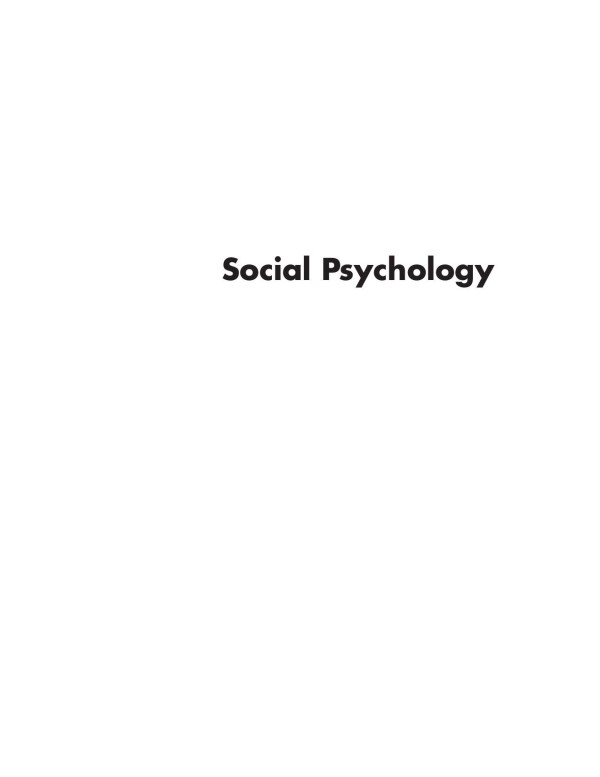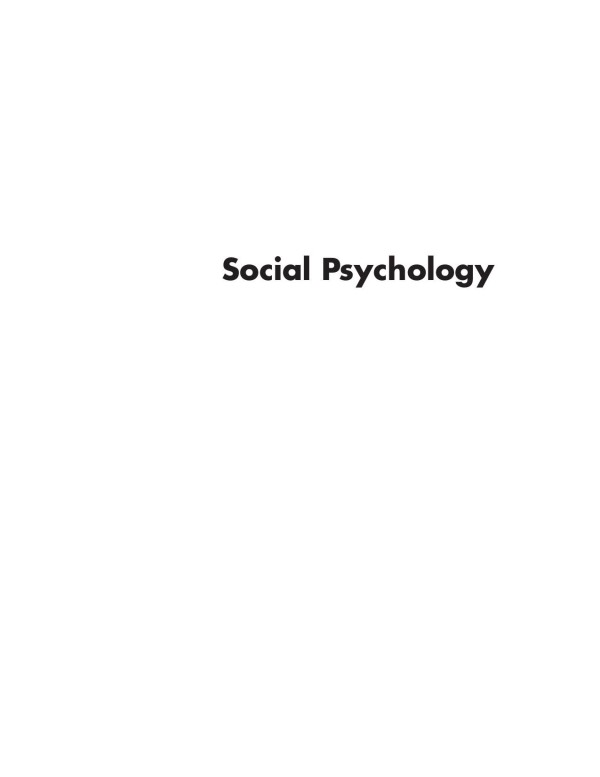Social Psychology 2nd Edition by Kenneth Bordens, Irwin Horowitz 1138136999 9781138136991
$50.00 Original price was: $50.00.$25.00Current price is: $25.00.
Authors:Bordens; Horowitz , Series:Psychology [140] , Tags:Psychology / General Psychology / Personality , Author sort:Bordens & Horowitz , Languages:Languages:eng , Published:Published:Jan 2008 , Publisher:Freeload Press
Social Psychology 2nd Edition by Kenneth Bordens, Irwin Horowitz – Ebook PDF Instant Download/Delivery. 1138136999, 9781138136991
Full download Social Psychology 2nd Edition after payment

Product details:
ISBN 10: 1138136999
ISBN 13: 9781138136991
Author: Kenneth S. Bordens; Irwin A. Horowitz
This second edition presents the core fundamentals of the subject in 11 manageable chapters while maintaining the book’s scientific integrity. The research methods students need to understand, interpret, and analyze social psychological research are emphasized throughout. The streamlined approach provides an economical textbook for students and a flexible format that allows instructors to cover the entire book in a single semester. A book specific Web site contains a free online study guide and a variety of teaching tools. An Instructor’s Manual/Test Bank and a Computerized Test Bank are also available.
Social Psychology 2nd Table of contents:
CHAPTER 1 Understanding Social Behavior
Social Psychology and the Understanding of Social Behavior
A Model for Understanding Social Behavior
Expanding Lewin’s Model
Social Psychology and Related Fields
Research in Social Psychology
Experimental Research
Correlational Research
Settings for Social Psychological Research
The Role of Theory in Social Psychological Research
Theory and the Research Process
Theory and Application
What do We Learn from Research in Social Psychology?
Do Social Psychologists Study the Obvious?
Do Exceptions Mean Research Results are Wrong?
Ethics and Social Psychological Research
Columbine High School Revisited
Chapter Review
Internet Activity
Suggestions for Further Reading
CHAPTER 2 The Social Self
Self-Concept
Self-Knowledge: How We Know the Self
The Influence of Groups and Culture on the Self
Self-Esteem: Evaluating the Self
Internal Influences on Self-Esteem
Self-Awareness
Self-Knowledge and Self-Awareness
The Cost and Ironic Effects of Self-Control
Managing Self-Presentations
Self-Esteem and Impression Management
Self-Monitoring and Impression Management
Self-Presentation and Manipulative Strategies
Self-Handicapping
The Impression We Make on Others
The Life of James Carroll Revisited
Chapter Review
Internet Activity
Suggestions for Further Reading
CHAPTER 3 Social Perception Understanding other People
Impression Formation: Automaticity and Social Perception
Automatic Processing
The Importance of Automaticity in Social Perception
Automaticity and Behavior
Automaticity and Emotions
Controlled Processing
The Impression others Make on us: How do we “Read” People?
How Accurate Are Our Impressions?
Confidence and Impression Formation
It is Hard to Catch a Liar: Detecting Deception
The Attribution Process: Deciding why People Act as They Do
Heider’s Early Work on Attribution
Correspondent Inference Theory
Covariation Theory
Dual Process Models
Attribution Biases
Misattributions
The Fundamental Attribution Error
The Sinister Attribution Error: Paranoid Social Cognition
Why We Make the Fundamental Attribution Error
Correcting the Fundamental Attribution Error
The Actor–Observer Bias
The False Consensus Bias
Constructing an Impression of others
The Significance of First Impressions
Schemas
Stories
The Confirmation Bias
Shortcuts to Reality: Heuristics
How We View Our Social World: Thinking about Thinking
Cognitive Optimism and Happiness
The Incompetent, the Inept: Are They Happy?
The Effects of Distressing and Joyful Events on Future Happiness
Bottom Line
The Vincennes Revisited
Chapter Review
Internet Activity
Suggestions for Further Reading
CHAPTER 4 Prejudice and Discrimination
The Dynamics of Prejudice, Stereotypes, and Discrimination
Prejudice and Stereotypes
Stereotypes
Discrimination
The Persistence and Recurrence of Prejudice and Stereotypes
Personality and Prejudice: Authoritarianism and Gender
The Authoritarian Personality
Gender and Prejudice
The Social Roots of Prejudice
Modern Racism
Changing Social Norms
The Cognitive Roots of Prejudice: From Categories to Stereotypes
Identify with the In-Group
A Biological Perspective on In-Group Bias
The Role of Language in Maintaining Bias
Illusory Correlations
From Illusory Correlations to Negative Stereotypes via the Fundamental Attribution Error
The Confirmation Bias
The Out-Group Homogeneity Bias
The Difference between Prejudiced and Nonprejudiced Individuals
The Consequences of Being a Target of Prejudice
Ways Prejudice Can Be Expressed
Coping with Prejudice
Reducing Prejudice
Contact between Groups
Personalizing Out-Group Members
Reducing the Expression of Prejudice through Social Norms
A Success Story: The Disarming of Racism in the U.S. Army
The Mormon Experience Revisited
Chapter Review
Internet Activity
Suggestions for Further Reading
CHAPTER 5 Attitudes
What are Attitudes?
Allport’s Definition of Attitudes
Attitude Structures
Explicit and Implicit Attitudes
Attitudes as an Expression of Values
What Do Attitudes Do for Us? The Function of Attitudes
How are Attitudes Measured?
The Attitude Survey
Potential Biases in Attitude Surveys
Behavioral Measures
How are Attitudes Formed?
Mere Exposure
Direct Personal Experience
Operant and Classical Conditioning
Observational Learning
The Effect of Television and Books
The Effect of Textbooks
The Heritability Factor
Attitudes and Behavior
An Early Study of Attitudes and Behavior
The Theory of Reasoned Action
Theory of Planned Behavior
The Importance of Conviction
Ideology
The Nonrational Actor
Mindless Behavior in Everyday Life
The Rational and Nonrational Actors: A Resolution
Ida Tarbell Revisited
Chapter Review
Internet Activity
Suggestions for Further Reading
CHAPTER 6 Persuasion and Attitude Change
The Yale Communication Model
The Communicator
The Message and the Audience
Social Judgment Theory
The Problem of Multiple Audiences
The Cognitive Approach to Persuasion
The Elaboration Likelihood Model
The Effect of Mood on Processing
The Effect of Personal Relevance on Processing
The Impact of Attitude Accessibility on Elaboration
Do Vivid Messages Persuade Better than Nonvivid Messages?
Need for Cognition: Some Like to Do It the Hard Way
The Heuristic Model of Persuasion
Cognitive Dissonance Theory: A Model of Self-Persuasion
Cognitive Dissonance Theory
Alternatives to Cognitive Dissonance Theory
Self-Perception Theory
Persuading the Masses
Public Health Campaigns: Educating People about AIDS
The Limits of Persuasion
The Leopold and Loeb Case Revisited
Chapter Review
Internet Activity
Suggestions for Further Reading
CHAPTER 7 Conformity, Compliance, and Obedience
Conformity: Going Along with the Crowd
Informational and Normative Social Influence
Social Norms: The Key to Conformity
Classic Studies in Conformity
How Does Social Influence Bring about Conformity?
Factors that Affect Conformity
Minority Influence
Can a Minority Influence the Majority?
Majority and Minority Influence: Two Processes or One?
Compliance: Responding to a Direct Request
Foot-in-the-Door Technique
Door-in-the-Face Technique
Low-Ball Technique
Compliance Techniques: Summing Up
Obedience
The Banality of Evil: Eichmann’s Fallacy
Ultimately, Who is Responsible for Evil Deeds?
Milgram’s Experiments on Obedience
Predicted Behavior and Results in the Milgram Experiment
Situational Determinants of Obedience
The Role of Gender in Obedience
Obedience or Aggression?
Obedience Across Culture, Situation, and Time
Reevaluating Milgram’s Findings
Critiques of Milgram’s Research
Disobedience
Breaking with Authority
Reassessing the Legitimacy of the Authority
Strength in Numbers
The Jury Room Revisited
Chapter Review
Internet Activity
Suggestions for Further Reading
CHAPTER 8 Group Processes
What is a Group?
Characteristics of Groups
What Holds a Group Together?
How and Why do Groups Form?
Meeting Basic Needs
Roles in Groups
How do Groups Influence the Behavior of Individuals?
The Effects of an Audience on Performance
The Distraction–Conflict Effect
The Effects of Group Participation on Performance
Groups, Self-Identity, and Intergroup Relationships
Why People Identify with a Social Category
Self-Categorization Theory (SCT)
The Power of Groups to Punish: Social Ostracism
Deindividuation and Anonymity: The Power of Groups to Do Violence
Group Decision Making and Group Productivity
Individual Decisions Versus Group Decisions
Does a Group do Better than its Best Member?
The Effect of Leadership Style on Group Decision Making
Factors That Affect the Decision-Making Ability of a Group
The Dynamics of Group Decision Making: Decision Rules, Group Polarization, and Groupthink
How Groups Blend Individual Choices into Group Decisions
Group Polarization
Groupthink
The Challenger Revisited
Chapter Review
Internet Activity
Suggestions for Further Reading
CHAPTER 9 Close Relationships
The Roots of Interpersonal Attraction and Close Relationships
Affiliation and Intimacy
Loneliness and Social Anxiety
Love and Close Relationships
Love’s Triangle
Types of Love
The Formation of Intimate Relationships
Attachment Styles and Adult Love Relationships
Determinants of Interpersonal Attraction
Dimensions of Physical Attractiveness
Physique and the Attractiveness Bias
Beauty and the View from Evolutionary Psychology
Dynamics of Close Relationships
Relationship Development
Evaluating Relationships
Love Over Time
Sculpting a Relationship
Responses to Conflict
Love in the Lab
Friendships
Gertrude and Alice Revisited
Chapter Review
Internet Activity
Suggestions for Further Reading
CHAPTER 10 Interpersonal Aggression
What is Aggression?
Levels and Types of Aggression
Gender Differences in Aggression
Factors that Contribute to Aggression
Biological Explanations for Aggression
Ethology
Sociobiology
The Physiology of Aggression
The Effects of Alcohol on Aggression
The Frustration–Aggression Link
Components of the Frustration–Aggression Sequence
Factors Mediating the Frustration–Aggression Link
The Social Learning Explanation for Aggression
The Socialization of Aggression
Aggressive Scripts: Why and how they Develop
The Role of the Family in Developing Aggressive Behaviors
Child Abuse and Neglect
Family Disruption
The Role of Culture in Violent Behavior
The Role of Television in Teaching Aggression
Viewing Sexual Violence: the Impact on Aggression
Reducing Aggression
Reducing Aggression in the Family
Reducing Aggression with Cognitive Intervention
Matthew Shepard Revisited
Chapter Review
Internet Activity
Suggestions for Further Reading
CHAPTER 11 Altruism
Why do People Help?
Empathy: Helping in Order to Relieve another’s Suffering
Empathy and Egoism: Two Paths to Helping
Challenging the Empathy–Altruism Hypothesis
Biological Explanations: Helping in Order to Preserve Our Own Genes
Reprise: Why do We Help?
Helping in Emergencies: A Five-Stage Decision Model
1. Noticing the Situation
2. Labeling the Situation as an Emergency
3. Assuming Responsibility to Help: The Bystander Effect
4. Deciding How to Help
5. Implementing the Decision to Help
Increasing the Chances of Receiving Help
Helping in Nonemergencies: Situational and Personality Influences
Righteous Rescuers in Nazi-Occupied Europe
The Oliners and the Altruistic Personality Project
Situational Factors Involved in Becoming a Rescuer
Personality Factors Involved in Becoming a Rescuer
Altruism as a Function of Child-Rearing Style
Altruism as a Function of Cognitive Development
Becoming an Altruistic Person
A Synthesis: Situational and Personality Factors in Altruism
The Interactionist View
Applying the Five-Stage Decision Model to Long-Term Helping
Noticing the Situation
Labeling the Situation as an Emergency
Assuming Responsibility to Help
Deciding How to Help
Implementing the Decision to Help
Altruistic Behavior from the Perspective of the Recipient
Seeking Help from Others
A Decision Model for Seeking Help
Factors Influencing the Decision to Seek Help
Reacting to Help When it is Given
Seth Conklin Revisited
Chapter Review
Internet Activity
Suggestions for Further Reading
People also search for Social Psychology 2nd:
social psychology and everyday life 2nd edition
social psychology and everyday life 2nd ed
social psychology examples
secondary drive psychology example
You may also like…
eBook PDF
Understanding Critical Social Psychology 1st Edition by Keith Tuffin 0761954961 9780761954965
eBook PDF
An Introduction to Social Psychology 1st Edition by William McDougall 113885123X 9781138851238
eBook PDF
Language as Social Action Social Psychology and Language Use 1st Edition by Thomas Holtgraves
eBook PDF
Social Psychology of Consumer Behavior 1st Edition by Michaela Wanke 1138882941 9781138882942












